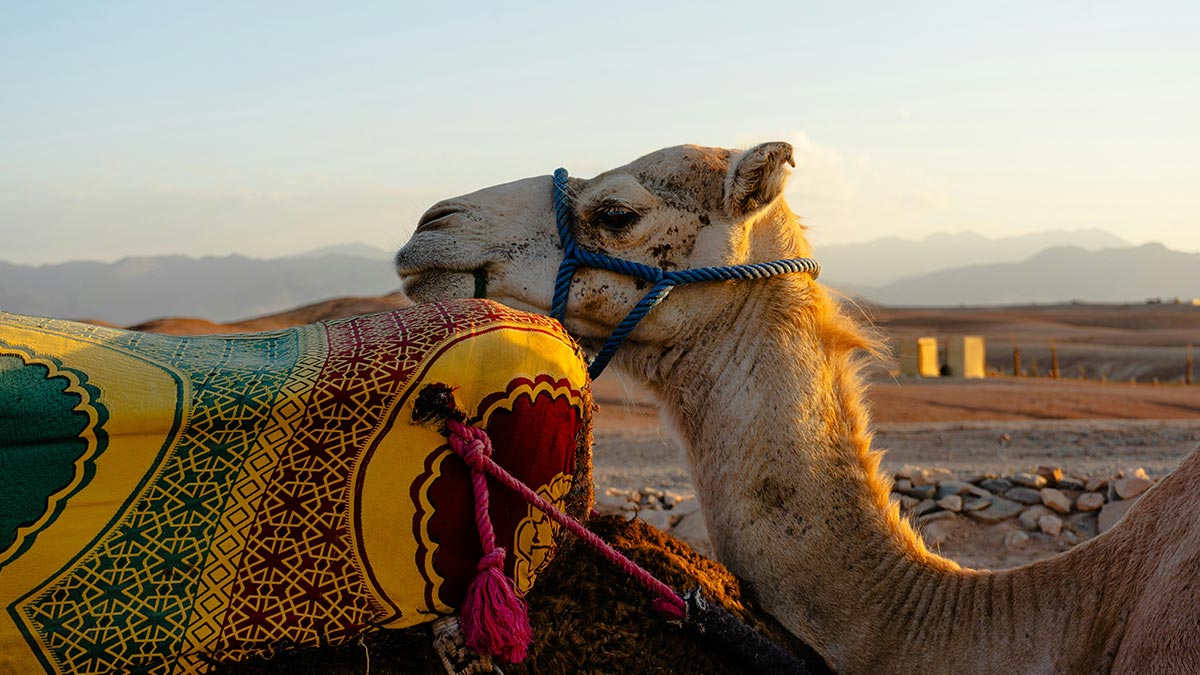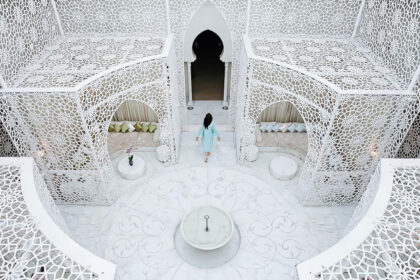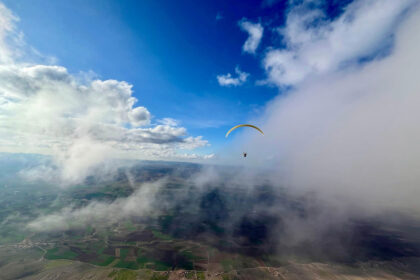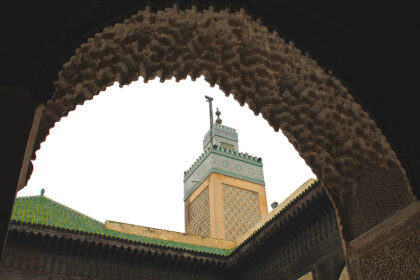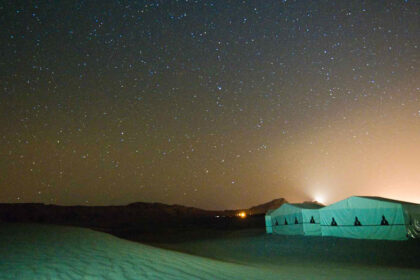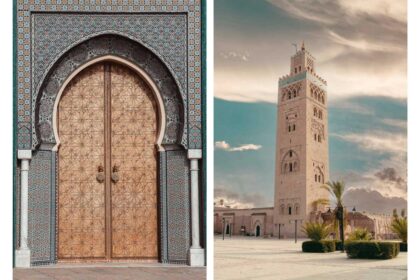The number of adventure-seeking tourists wanting to visit Morocco has been increasing exponentially over the last few years and 2024 is set to break all records. And, of course, one of the very first things that a visitor dreams of experiencing is an authentic camel trek in the Sahara Desert. But how does one separate genuine experiences from tourist traps or value from money from a blatant rip-off? Many travellers feel overwhelmed by the myriad of options and don’t know which one to choose.
Camel Trekking in Marrakech offers the perfect solution to this problem. At a fair price, it offers authentic treks near the major tourist hub of Marrakech and is a unique way to explore the area’s natural beauty and rich culture.
Just imagine swaying gently atop a docile giant, moving sedately over golden dunes as the burning globe of the sun sets beyond the Saharan horizon. Camel trekking Marrakech style allows you to travel back in time to an exotic, ancient era and feel a close connection with nature.
The Agafay Desert is the northwestern area of the mighty Sahara and Agafay Desert camel trekking experience is an unmissable opportunity, just a short drive from Marrakech, offering stunning views of the towering Atlas Mountains.
But when should you go? What time of year? The best time for your camel trekking depends on your comfort level. Spring and fall offer mild temperatures, while summer brings intense heat and winter can be chilly.
This guide will walk you through everything you need to know about camel trekking near Marrakech. We’ll cover the best camel tours in Morocco, what to pack, and how to prepare for your desert adventure.
Get ready to forge unforgettable memories on the back of a camel in Morocco’s breathtaking landscape.
Planning Your Marrakech Camel Trek
Best Time for Camel Trekking
Seasonal considerations
The time of year that you choose for your camel trek can make a big difference. Each season in Marrakech has its own individual charm. Spring brings mild temperatures and blooming wildflowers. Summer is hot but great for star-gazing. Fall offers comfortable weather and fewer, smaller crowds. Winter can be cool but offers clear skies.
Weather conditions
Marrakech’s weather can play an important role in your trek experience. Summer days can be sweltering, averaging nearly 100°F (37°C) and often over 105°F (40°C). Winter nights may drop to 45°F (7°C). Spring and autumn have the most pleasant temperatures. Always check the forecast before you go and pack accordingly. But bear in mind the forecast can change rapidly.
Peak vs. off-season advantages
The peak seasons for holidaying in Marrakech are the cooler, but not cold months of March to May and September to November when the weather is ideal. But this also means more tourists and higher prices. Off-season can be cheaper and considerably less crowded. You might also enjoy a more personal experience. Just be ready for extreme temperatures if you decide to visit in summer or winter.
Choosing the Right Duration
Short camel rides VS multi-day camel treks
A Short camel-trekking ride lasts only a few hours and is a great start for beginners or those with limited time. You’ll get a taste of camel trekking without a big time commitment. A multi-day trek offers a more in-depth desert experience. You’ll camp in a Berber-style tent under the stars and can truly immerse yourself in the surroundings.
Most people choose either a half-day (2-3 hours) or a full-day (4-6 hours) trek. These fit easily into a standard Marrakech visit. For those with more time, 2-3 day treks are common. They let you explore further into the desert and enjoy overnight camping, stargazing, and the sunset and sunrise over the desert.
Many tour companies offer custom treks. You can often adjust the length, route, and activities to fit your individual requirements. This is ideal if you have specific interests or time constraints. Don’t be afraid to ask about tailoring your trek experience.
Camel Trek Destinations from Marrakech
Agafay Desert – the closer option
If you’re short on time, the Agafay Desert is a great alternative for camel trekking. It’s only about 30 minutes from Marrakech by car. While it’s not a sand desert like the Erg Chebbi area or other parts of the Sahara, it is, like the larger parts of the Sahara, hamada, or rock desert, still extremely beautiful in its own way. You can do day trips or overnight stays here. The Agafay Desert offers views of the Atlas Mountains and a quieter, more relaxed experience than the city. It’s perfect for those who want a desert feel without a long journey.
Sahara Desert routes
The Sahara Desert is the ultimate camel trekking destination. It’s about a 9-hour drive from Marrakech, but well worth the journey if you have the time. Here, you’ll discover seemingly endless dunes and a truly remote feel. Most Sahara treks last 2-3 days. You’ll ride camels, camp in traditional Berber tents, and watch stunning sunrises and sunsets. The night sky in the Sahara is unforgettable, with countless stars visible to the naked eye, the Milky Way like a white scarf above you, and the moon appearing large and close enough to touch.
Popular locations: Erg Chebbi, Erg Chigaga, Erg Lihoudi, Tinfou Dunes.
Erg Chebbi. Next to the small town of Merzouga, is known for its huge dunes, some over 150 metres high. It’s a favourite spot for photographers and adventure seekers and is the most popular desert location for tourists. Many treks start here, and it offers a tantalising glimpse of desert life. The Erg Chigaga and Erd Lihoudi dunes, both near Mhamid, are not as popular, large, or beautiful but the Erg Chicaga, close to Zagora is further south. less spoiled and touristy and the biggest and most beautiful of the lot. It’s also known for its palm groves and more rugged desert landscape. Being further away and off main roads it is a much longer and demanding journey though Each of these places offers a unique take on the Moroccan desert experience.
Atlas Mountains treks
A few camel treks are offered that combine desert and mountain scenery. These routes take you through the foothills of the Atlas Mountains. You’ll pass by traditional Berber villages and lush river valleys. The landscape changes from rocky plains to green hills and vales. These treks often include both camel riding and some hiking. They’re perfect for those who enjoy varied scenery and a bit more of a challenge.
Read also: The 11 best hiking trails in Morocco
Accommodation Options
Luxury desert camps
Luxury desert camps offer a high-end desert experience. You’ll find comfortable beds, private bathrooms, and gourmet meals. These camps often have beautifully decorated tents with rugs and lanterns. Some even offer air conditioning. You’ll enjoy the desert without giving up modern comforts. Luxury camps usually have expert guides and offer extra activities like sandboarding or 4×4 tours. They are, of course, considerably more expensive and not as authentic as some other options.
Traditional Berber tents
For a more authentic experience, It is a good idea to try staying in a traditional Berber, desert nomad tent. These are made of thick fabric and are surprisingly cozy inside. You’ll sleep on mats or simple beds with warm blankets. The traditional meals are usually cooked over an open fire, where guests and Berbers will gather around to exchange stories, listen to local music, and gaze at the stars. Go for a barefoot walk in the desert and feel the sand between your toes. This option allows you to experience desert life as the locals have for centuries. It’s a great way to learn about Berber culture and traditions.
Sleeping under the stars
Some treks allow adventurous explorers to sleep directly under the night sky. You’ll have a mattress and sleeping bag, but no tent. This is perfect for stargazers and those who want to feel truly connected to nature. The desert sky is incredibly clear, and you will see the broad band of the Milky Way, likely the huge-looking moon, and quite possibly, shooting stars. Just be prepared for cooler nighttime temperatures and maybe some sand in your sleeping bag and hair! 😄
Eco-friendly and glamping alternatives
Eco-friendly camps focus on leaving a minimal impact on the desert environment, ecosystem, and ecology. They often make use of solar power, compost toilets, and locally sourced ingredients for meals, thus also supporting the local economy.
Glamping (glamorous camping) options blend comfort with nature. You might find canvas tents with real beds, private terraces, and even small swimming pools. These camps try to balance luxury with environmental responsibility. They’re super for those who want comfort but also care about sustainability.
Budgeting for Your Camel Trek
Price ranges and what’s included
The cost of a camel trek can vary wildly. A short, few-hour-long, day trip can cost around $30-$50 per person. Multi-day treks to the Sahara might range from $150 to $500 or more. Luxury options can go much higher. Most treks include camel rental, guide fees, meals, and accommodation. The majority also cover transport from Marrakech. Always check what’s included in the price and what’s not. Ask about extras like sleeping bags, water, entrance fees to any sites you’ll visit, and expected gratuities.
Several factors can affect the price of your trek. Naturally, the length of the trip is a big issue. Longer treks will obviously cost more but often offer better value per day. The type of accommodation matters too as luxury camps are generally going to cost more than basic tents. The season affects prices, with peak times being more expensive than out-of-season treks. Group size may also impact cost. Private tours usually cost more than joining a group. The reputation and quality of the tour company will also affect the price that you have to pay.
Tips for finding deals and discounts
To save money, consider travelling in the off-season. Prices are often lower from June to August and December to February. Booking in advance can sometimes get you early bird discounts. On the other hand, last-minute deals are possible if tour operators need to fill places. Travelling in a group can lower the cost per person. Some companies offer child, student, or senior citizen discounts, so ask about these. Compare prices from different operators, but be sure to check what’s included. Sometimes a higher price offers better value. Don’t be afraid to negotiate, especially for longer treks or group bookings. Haggling is normal in Morocco and can result in large price reductions.
Preparing for Your Camel Trek
What to pack
We recommend that you pack light but smart for your camel trek. Bring loose, comfortable clothing that covers your skin, including arms and legs. This protects you from the sun and sand. Long trousers, long-sleeved shirts, and a light jacket are essential. Don’t forget a wide-brimmed hat and your sunglasses. Comfortable closed-toe shoes are a must. Pack sunscreen, lip balm, and a reusable water bottle. A small backpack/ knapsack is useful for day trips. For overnight treks, bring a warm layer for cool nights. A torch, flashlight, or headlamp comes in handy. Consider bringing wet wipes and hand sanitizer for hygiene on the go.
Health and safety considerations
Perhaps the most important advice is to stay hydrated during your trek. Ensure that you drink more water than you think you need. Protect yourself from the sun with sunscreen, a hat, and sunglasses as well as loose-fitting clothing. If you have any health issues, discuss them with your doctor before the trip. Bring any necessary medication. Motion sickness can be an issue for some people on camels. If you’re prone to it, bring the appropriate medicine. Be careful when mounting and dismounting your camel. Listen to your guide’s instructions. Let your guide know if you feel unwell or need a break. It’s normal to feel sore after riding but speak up if you’re in pain.
Etiquette and cultural sensitivity
Please respect local customs and traditions during your camel trek. Dress modestly, covering your shoulders and knees. Ask permission before taking photos of people, especially in rural areas. Learn a few basic Arabic or Amazigh (Berber) phrases. Your guides, camel handlers, and the locals that you meet will appreciate the effort. Be patient and flexible. Desert life moves at a different pace from what you are probably used to. Treat your camel and guides with respect. Don’t expect luxury in traditional camps. Be open to trying local foods and customs. If you’re invited to share tea, it’s considered polite to accept. Avoid public displays of affection. Tipping is common, so ask your tour operator about the appropriate amounts for gratuities for guides and camel handlers.
Enhancing Your Camel Trek Experience
Combining with other activities (e.g., sandboarding, stargazing)
Make the most of your desert trip by trying other activities. Many tours offer sandboarding on the dunes which is essentially snowboarding, but on sand. No experience is needed, and it’s a fun way to get an adrenaline rush. Stargazing is a must-do in the desert. The unpolluted atmosphere produces clear, dark skies that offer amazing views of stars, the moon, and planets. Some tours take along telescopes for guests to take a closer look. You might also try a 4×4 desert tour, traditional music and dance shows, or desert nomad cooking classes. These add-ons can turn your camel trek into a fuller desert adventure.
Photography tips
The desert offers stunning photo opportunities. Early morning and late afternoon provide the best light for photos. These “golden hours” create beautiful shadows on the dune which shift and lengthen or shorten as the sun rises or sets. Capture the lines and patterns in the sand for abstract shots. For camel photos, get low to the ground for an interesting angle. The night sky can also provide some excellent opportunities for stunning photographs. Protect your camera from sand with a plastic bag or special cover. Bring extra batteries, as the heat can drain them quickly.
Don’t forget to put the camera down sometimes and just enjoy the moment. Some of the best memories won’t be captured on film.
Learning about camel care and Bedouin culture.
It is very satisfying to take the time to learn about the camels and the local people who work with them. Ask your guide about camel behaviour and care. You might even get a chance to help feed or groom the camels. This can deepen your appreciation for these amazing animals. Many guides are happy to share stories about Bedouin life in the desert. You can learn more about their culture by asking about their traditions, music, and daily routines. You might learn about desert navigation, traditional medicine, or how they can find water in this arid wilderness. Showing interest in the local culture can lead to rich conversations and a more meaningful trek experience.
Booking Your Camel Trek
Choosing a reputable tour operator
Picking the right tour operator is key to a great camel trek. Look for companies with a large number of good online reviews on sites like TripAdvisor or Google. Check how long they’ve been in business and their recent reputation. Established operators often have more experience and better safety records. Ask if they’re licensed and fully insured. Good operators will be happy to answer your questions and provide clear information. Consider booking through your hotel or a trusted travel agency. They often work with reliable local operators. Don’t just go for the cheapest option. Quality and safety should be your top priorities.
Questions to ask before booking
Before you book, ensure get all the details possible regarding your trek. Ask about the exact itinerary and what’s included in the price and what isn’t. Find out about the group size and if there’s a minimum number of participants. Ask about the experience level of the guides and if they speak your language. Inquire about the type of camels used and their treatment. Check what kind of safety measures they have in place. Ask about their cancellation policy and if they offer any insurance. Find out about the food provided, especially if you have dietary restrictions. Don’t be shy about asking for photos of the accommodation if it’s an overnight trek.
Customisation options
Most of the best tour operators offer ways to customise your trek. You might be able to adjust the length of the trip or add extra activities. Some allow you to upgrade your accommodation or choose specific campsites. If you have special interests, like photography, palaeontology, or birdwatching, ask if they can tailor the trek. For groups, you might be able to create a fully customised itinerary catering precisely to your needs. Some operators offer private guides for a more personal experience. If you have mobility issues or other special needs, discuss these with the operator. They can often provide decent solutions. Remember, customisation often comes with added costs, so be clear about your budget.
Camel trekking in Marrakech offers a unique blend of adventure, culture, and natural beauty. From the awesome, golden dunes of the shifting Sahara to the rocky, “hamada” landscape of the Agafay Desert, each trek provides each traveller with unforgettable experiences. You’ll ride gentle giants, sleep under starry skies, and connect with ancient Berber traditions. Whether you choose a short, one-day trip of a few hours or a multi-day expedition, you’ll gain a new perspective on Morocco’s diverse landscapes and rich heritage.
Don’t miss the chance to experience this timeless journey. Camel trekking lets you step away from the busy, modern rat race and into a slower, more peaceful, oft-forgotten world. It’s a chance to challenge yourself, learn about a different culture, and create memories that will last you a lifetime. Whether you’re a solo traveller, a couple, or a family, there’s a camel trek that’s right for you. The desert is calling – are you ready to answer?







